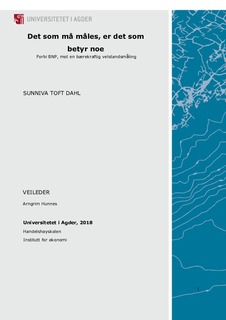| dc.description.abstract | The basis for this thesis is the question “how to measure prosperity within a sustainable perspective?”. To answer this, we will first look at the terms prosperity and sustainability. Prosperity is a term that holds more than a person’s income. An individual’s basic needs, access to health care and education, and life satisfaction are also of importance (Coyle, 2014, s. 75). These are factors of what we will call the individual dimension of prosperity. Two other dimensions of this term will also be presented; the social dimension, which includes the stability in a society and access to work, and a dimension focusing on the environment. In this context, it is of interest to view the term sustainability; prosperity today should not be at the expense of prosperity in the future (FN-Sambandet, 2018a).
We then look at the term gross domestic product (GDP), because this is a term often used when measuring prosperity today. GDP is a measure of production, and it tells us something about the state of an economy (Steigum, 2004, s. 35). If we distribute a country’s GDP onto its citizens, theoretically, we get the measure GDP per capita. This gives us an indication on the average income in a population (Coyle, 2014, s. 76; Jackson, 2017, s. 3). However, GDP is also used to estimate prosperity in the world. The grounds for doing so is that the higher the income of a person, the higher consumption of goods he is assumed to be able to have. Further, this can lead to increased utility and prosperity, at least in a material sense (Jackson, 2017, s. 23). Some critiques of GDP will also be presented, and we will see that this is a measure that is not adequate when it comes to measure prosperity.
On this basis, we will present fourteen alternative prosperity measures. These will be categorized into four categories. The first category includes measures that adjust GDP according to the critics presented. The second category includes measures that completely disregard the economic perspective, and the third includes measures that complement GDP. Finally, the fourth category include measures with a broad election of factors that can measure prosperity. The measures in this category are called ‘dashboard indicators’.
We than go even further and look deeper into the two measures that best cover the term prosperity; Sustainable Economic Development Assessment (SEDA) and Legatum Prosperity Index (LPI). It is considered whether these can measure prosperity within a sustainable perspective. In the end we conclude that an adjusted combination of the two is the best, and we suggest an overview of what a prosperity measure aiming for sustainability should contain. | nb_NO |

